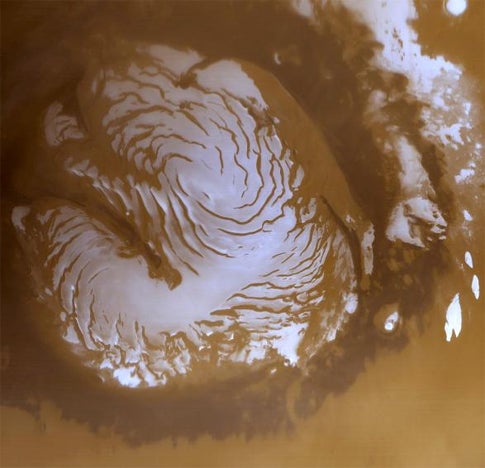Planetary scientists say the carbon-dioxide snow on Mars falls heavier in the northern hemisphere than in the southern. David Smith of NASA’s Goddard Space Flight Center and Maria Zuber of MIT discovered this disparity after measuring snow depths in both hemispheres over the course of a full martian year. They reported their findings Monday at the 38th Lunar and Planetary Science Conference in Houston.
Smith and Zuber didn’t have a ruler to stick in the ground, but they had the next best thing: approximately 700 million observations from which they built an accurate topographical map of the Red Planet. These data came from the laser altimeter on the now-defunct Mars Global Surveyor spacecraft. The researchers then looked at how the ice-cap elevation changed with the seasons between February 1999 and June 2001.
Not surprisingly, Smith and Zuber found snow depth increased fastest in late fall, when atmospheric temperatures plummet and carbon dioxide precipitates out of the air. What did surprise the two was the difference between the northern and southern hemispheres. In the north, snow depth increased steadily northward from about 50° latitude, then took a big jump at 80° latitude — the edge of the permanent polar cap — where it reached a maximum depth of about 80 inches (2 meters). The polar cap itself showed less snow accumulation.
Snows in the southern hemisphere showed two major differences. First, the snow depth increased steadily from 50° south latitude all the way to the pole. There were no sudden jumps, and no pronounced change at the permanent polar cap’s edge. Second, the total volume of snow in the southern hemisphere is significantly less than in the northern.
So what would carbon-dioxide snow look like? We may find out. The Phoenix Mars mission is slated to launch this August and land on Mars in May 2008. Mission planners hope to land the sophisticated probe at 70° north latitude — a prime position for observing any snowfall.










